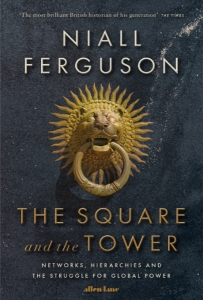In The Square and the Tower: Networks, Hierarchies and the Struggle for Global Power, Niall Ferguson offers an account of the historical interplay between vertical hierarchies and horizontal networks, with a focus on two key ‘Age of Networks’. While finding the book more of a synthesis of ideas than the definitive text on its studied phenomena, Vlad Onaciu recommends this as a valuable entrypoint for readers interested in the relationship between ‘the vertical tower and the horizontal square’.
The Square and the Tower: Networks, Hierarchies and the Struggle for Global Power. Niall Ferguson. Allen Lane. 2017.
Niall Ferguson’s The Square and the Tower: Networks, Hierarchies and the Struggle for Global Power is an attempt at explaining the inter-connectivity of the world we live in through the lens of history, while also keeping an eye on the near future. In the past three decades, it is easy to identify a certain trend in this direction. It started with Francis Fukuyama’s highly optimistic view of ‘the end of history’ after the fall of Communism, going on to Samuel Huntington’s fear of ‘a clash of civilisations’ to Noah Yuval Harari’s more recent and quite bleak prediction of humankind being overtaken by its technologies.
Ferguson is by now well-known as a historian, economic analyst and a public commentator on current affairs. His books have focused on the economic aspects of events and phenomena from the past. He debuted with Paper and Iron, in which he analysed how the interworkings of the German economy led to the disaster of the interwar years. He later moved on to explore the Rothschilds, writing what is probably the best history of the family. His other books have also focused to a certain degree on networks: The Cash Nexus, The Ascent of Money and The Pity of War. What determined him to write The Square and the Tower was his work on Henry Kissinger’s biography, where he truly learned about the role of networks.
Ferguson positions networks at the basis of human innovation, arguing that they have allowed us to construct modern civilisation. In this respect, networks are extremely varied, including patterns of settlement and migration in the early days of humanity, but also cults and crazes that sprout without any real plans. He attempts to explain the differences between networks and hierarchies, which are based on how we perceive the hubs and nodes connecting people. While networks build these in a horizontal direction, hierarchies do the same, only in a downward fashion, never at the same level.
 Image Credit: (jachu666 CCO)
Image Credit: (jachu666 CCO)
The book is focused on the relationship between hierarchies and networks, between ‘the vertical tower and the horizontal square’. The metaphor of the tower is meant to illustrate official power, and how it stands atop the square and its various exchanges between individuals. The book’s main thesis is that there have been two ages of networks, characterised by the traditional system’s failure to maintain its monopoly on power. This began with the invention of the mobile printing press, allowing for the spread of revolutionary ideas, ending at the close of the nineteenth century. The Second Age began in the 1970s and boomed with the spread of the internet as well as the disintegration of the Soviet Union.
The first period began with the invention of Johannes Gutenberg’s mobile printing press. Ferguson holds that this allowed for Martin Luther’s ideas to spread and thus for the Reformation to happen. This led to the contestation of old ideas and, eventually, to the birth of the Enlightenment. From here on, Ferguson looks at the history of particular networks, while always trying to distance himself from conspiracy theorists in underlining that it is only hierarchies that give power; networks, instead, are sources of influence.
The most important example in this respect is the fate of ‘the Illuminati’. This organisation, founded in 1776 in Bavaria by members of the elite, became extinct by 1787. This is considered somewhat peculiar by Ferguson, as they seem to be far more popular in stories than the more successful Freemasons. The latter even played important roles in major events, having close ties to the American Revolution. In the author’s opinion, this was due to the fact it had a hierarchical structure and, most importantly, a ritual which facilitated interactions between noblemen and clergymen. In fact, Ferguson argues that this allowed American revolutionaries to cooperate more efficiently.
It is from here, for Ferguson, that an inherent relationship between networks and revolutions emerges. This is due to their capacity to generate new ideas, which very often stand in opposition to existing power structures. In contrast to the American example, he brings the French Revolution, which lacked well-organised networks, inevitably leading to chaos and anarchy. But this only comes to confirm Ferguson’s conviction that these phenomena are inherently linked.
The First Age of Networks ended in the nineteenth century, when the state was finally capable of containing the powers unleashed by Gutenberg’s invention. Ferguson argues that even intellectual networks became hierarchical structures during this period. This phenomenon reached its peak by the middle of the twentieth century with the rise of totalitarian regimes. He argues that both Nazism and Communism only grew more hierarchical as they expanded, with massive bureaucracies being the key manifestation of this. The author presents this as something similar to a network, but functioning as an interaction between differing levels, never in a horizontal fashion, allowing for the concentration of power.
The Second Age of Networks began at the end of the 1970s. Throughout this part of the book, Ferguson explores various examples from Kissinger’s web of connections to influential individuals to the decentralised form taken by terrorist organisations. But it all culminates with a discussion of the internet and online social networks, focusing on the two giants, Facebook and Google. While Ferguson does appreciate the facilitation of communication between individuals these have brought, he underlines some of the dangers they might also come to pose. The main examples he highlights are the success of ISIS propaganda and the results of the Brexit referendum and the US Presidential election of 2016. In the first case, he talks about how the internet has allowed the organisation to become something similar to an open-source network, as it is acephalous, each member adding new information. This has made it flexible, capable of operating anywhere. The second example is characterised as a failure of the old elite to adapt and properly use new instruments. This ties into Ferguson’s idea that the internet might in fact pose a threat to democratic order as we know it. It can be used to undermine governments, but these in turn can also use online networks to control the population (e.g. in the cases of China and Russia).
The Square and the Tower stands as another addition to the expanding literature trying to explain the direction in which the world is heading. For those interested in answers coming from historical examples, it is by far one of the best choices. In terms of an analysis of networks and hierarchies, it does not stand as the definitive book, but rather, as Ferguson himself admits, as more of a synthesis of a broad phenomenon. It is without a doubt a good read, especially for those looking for an entry point into the subject.
Vlad Onaciu is a PhD student in the Faculty of History and Philosophy at Babes-Bolyai University, where he previously finished his BA and MA in contemporary history. His doctoral research focuses on issues regarding the lives of workers in factories during the communist regime in Romania. His academic interests include the history of communism, oral history, international relations (mainly civilisational studies) and nineteenth- and twentieth-century history in general. Read more by Vlad Onaciu.
Note: This review gives the views of the author, and not the position of the LSE Review of Books blog, or of the London School of Economics.


 Find this book:
Find this book: 





4 Comments